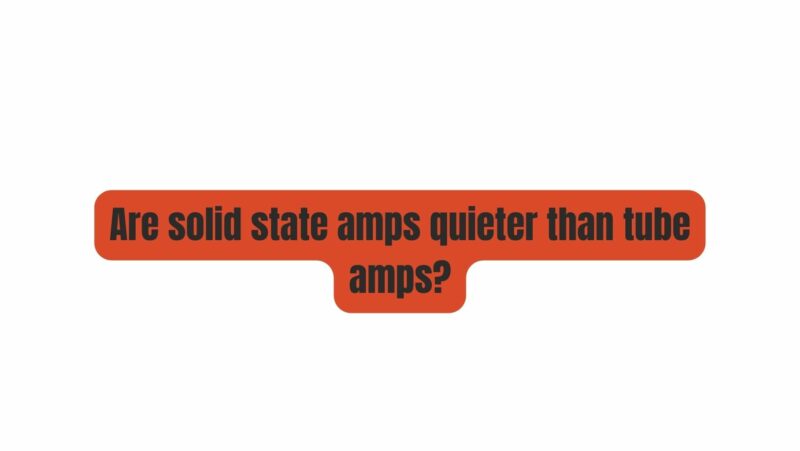In the realm of audio amplification, the debate between solid-state amplifiers and tube amplifiers has been ongoing for decades. One of the age-old misconceptions surrounding this debate is the belief that solid-state amplifiers are inherently quieter than their tube counterparts. In this comprehensive exploration, we aim to unravel the complexities of audio amplification, the characteristics that define solid-state and tube amplifiers, and whether the assertion that solid-state amps are quieter holds any validity.
Understanding Amplification and Sound Levels
Before delving into the specifics of solid-state and tube amplifiers, it’s crucial to grasp the fundamental concepts of amplification and sound levels. An amplifier’s primary function is to increase the amplitude or volume of an audio signal, allowing it to drive speakers and produce audible sound. The loudness of the sound produced by an amplifier is typically measured in decibels (dB), with higher dB values indicating greater perceived loudness.
Several factors influence the perceived loudness of an amplifier, including:
- Power Output: The wattage rating of an amplifier’s power output is a fundamental determinant of how loudly it can drive speakers. Amplifiers with higher wattage ratings have the potential to produce greater volume levels.
- Sensitivity: Sensitivity, often expressed in dB, is a measure of how efficiently an amplifier converts electrical input into sound output. Amplifiers with higher sensitivity ratings require less power to achieve the same volume levels.
- Impedance Matching: Matching the impedance of the amplifier to that of the speakers is crucial for optimizing power transfer and achieving maximum loudness.
- Distortion: Distortion, whether harmonic or otherwise, can significantly affect the perceived loudness of an amplifier. Clean amplifiers with low distortion tend to produce more accurate and consistent volume levels.
- Speaker Efficiency: The efficiency of the speakers used in conjunction with the amplifier plays a significant role. Highly efficient speakers can produce more sound output with less power.
With these foundational concepts in mind, let’s delve into the characteristics of solid-state and tube amplifiers and assess whether solid-state amplifiers are indeed quieter.
Demystifying Solid-State Amplifiers
Solid-state amplifiers, also known as transistor amplifiers, utilize semiconductor components such as transistors and integrated circuits to amplify audio signals. These amplifiers have gained popularity due to their reliability, efficiency, and compact design. To understand whether solid-state amplifiers are quieter, we must explore the unique attributes that define them:
- Power Output: Solid-state amplifiers are renowned for their ability to deliver high power output, which allows them to drive a wide range of speakers to loud volumes. The high power output potential of solid-state amplifiers often dispels the notion that they are quieter.
- Efficiency: Efficiency is a hallmark of solid-state amplifiers. They can efficiently convert electrical energy into sound output, resulting in cleaner and more efficient amplification. This efficiency contributes to their capacity for high-volume performance.
- Clean Sound: Solid-state amplifiers are known for their ability to produce clean, distortion-free sound. This clarity ensures that the sound produced remains consistent and accurate at various volume levels, enhancing the perception of loudness.
- Heat Dissipation: Efficient heat dissipation mechanisms in solid-state amplifiers enable them to maintain performance quality even during prolonged high-volume use. This aspect is crucial for consistent and reliable loudness.
- Low Distortion: Solid-state amplifiers typically exhibit low levels of distortion when operated within their rated power range. This low distortion contributes to their reputation for producing clean and clear sound at any volume.
Comparing with Tube Amplifiers
To assess whether solid-state amplifiers are quieter than tube amplifiers, it’s essential to compare them to their tube counterparts:
- Tube Amplifiers: Tube amplifiers, also known as valve amplifiers, are celebrated for their characteristic harmonic distortion and warm sound signature. While they may not offer the same power output as solid-state amplifiers, they possess a unique sonic character that appeals to many listeners.
- Class D Amplifiers: Class D amplifiers, often referred to as digital amplifiers, are known for their high efficiency and compact design. They can produce substantial sound output while generating minimal heat, challenging the notion that solid-state amplifiers are always quieter.
- Hybrid Amplifiers: Some amplifiers combine solid-state and tube technologies, aiming to strike a balance between the clean, high-volume capabilities of solid-state amplifiers and the harmonic richness of tube amplifiers.
The Perception of Quieter Sound
It’s essential to recognize that the perception of loudness is subjective and can be influenced by various factors. The characteristics of the music being played, the quality of the source material, and the acoustics of the listening environment all contribute to how quiet or loud an amplifier may sound.
Additionally, personal preferences and listening habits play a significant role in determining whether an amplifier is perceived as quieter. Some listeners may favor the clarity and efficiency of solid-state amplifiers for their high-volume capabilities, while others may embrace the harmonic character of tube amplifiers, even at lower volumes.
Conclusion
In the pursuit of answering the question, “Are solid-state amplifiers quieter than tube amplifiers?” we find that the answer is nuanced and multifaceted. Solid-state amplifiers possess characteristics that enable them to deliver high volume levels, including their high power output, efficiency, clean sound reproduction, and low distortion. However, the perceived loudness of an amplifier is influenced by a multitude of factors beyond amplifier type.
Ultimately, the choice between solid-state, tube, or other amplifier types should align with individual preferences, musical genres, and listening environments. Some listeners may prefer the clarity and efficiency of solid-state amplifiers for their high-volume capabilities, while others may embrace the harmonic character of tube amplifiers, even at lower volumes. In the world of audio, the pursuit of excellence in sound should prioritize the enjoyment of music and sound quality, rather than focusing solely on the perceived loudness of an amplifier.


